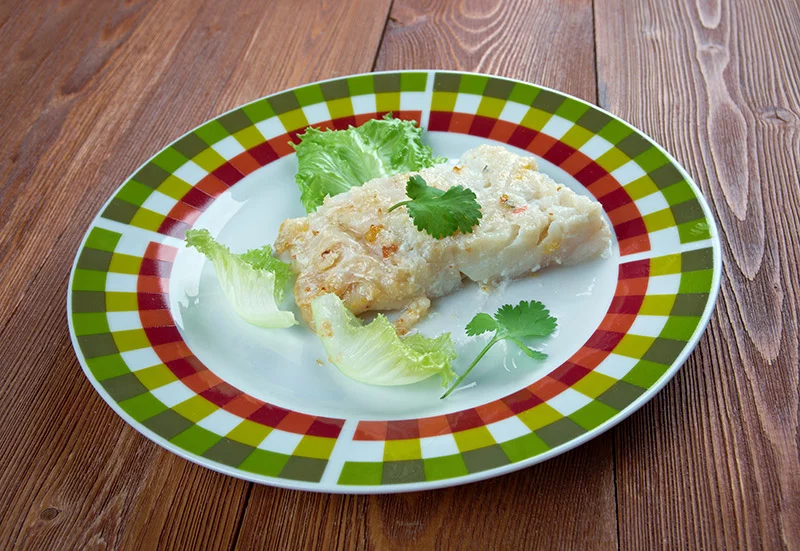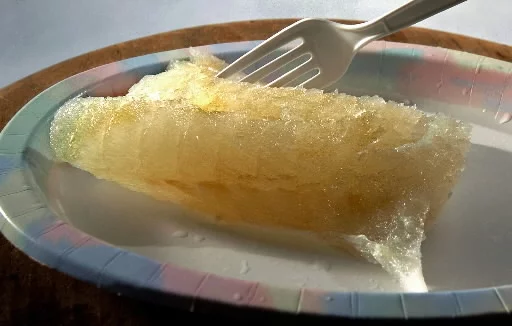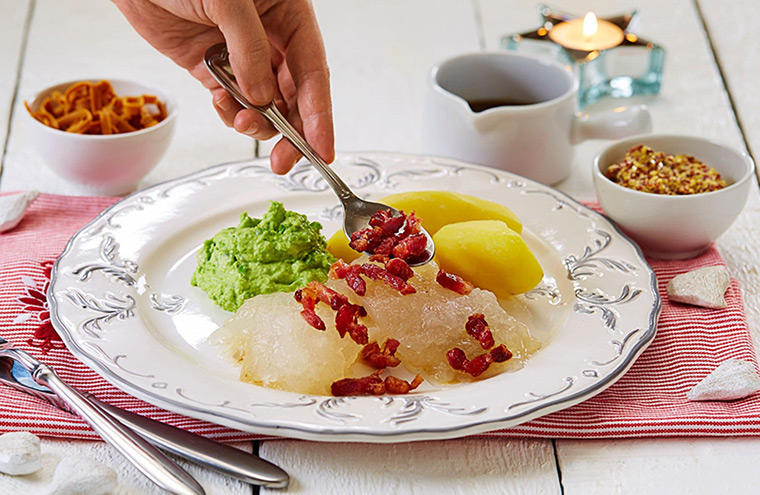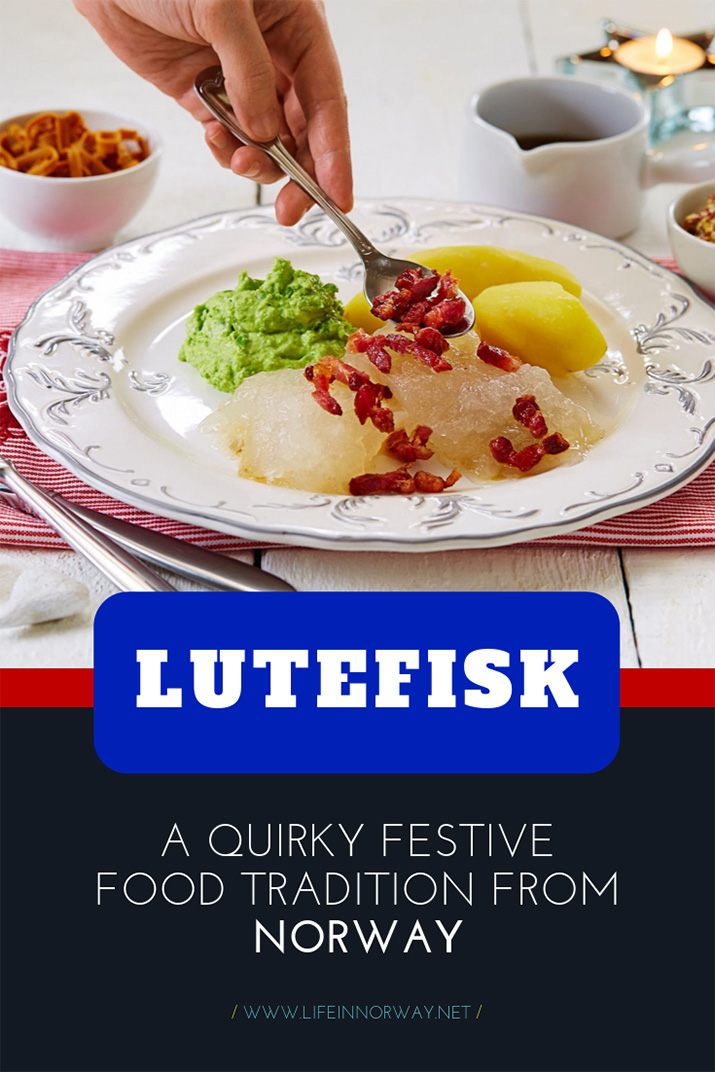
A Norwegian dish that divides opinion like no other, lutefisk is a traditional fish-based dish eaten in the months before Christmas.
This morning on my daily walk to Jerbanetorget, I wandered past the Norwegian restaurant Dovrehallen, as usual. Panic set in as I saw the latest addition to the menu – lutefisk.
The time has come for me to write about this oh so very Norwegian of dishes!
You love it or hate it
Yes folks, lutefisk season has begun. Perhaps the best way to explain lutefisk is as the Norwegian version of Marmite. For those non-Brits out there, that means something you either love or hate. Although I have a sneaky suspicion that those who claim to love lutefisk, really don’t!
“It can be tasty, but the statistics aren’t on your side. It is the hereditary delicacy of Swedes and Norwegians who serve it around the holidays, in memory of their ancestors, who ate it because they were poor. Most lutefisk is not edible by normal people” – Pontoon
What is lutefisk?
So, lutefisk starts out its life as cod. Lovely, fresh cod! I believe other white fish can be and is used, but cod is by far the most common. Surely it can't be all bad then, I hear you say? Hold on! This is what happens next.
The cod is then air-dried. Once it's ready to be cooked, it is soaked in water for several days, with the water changed each day. Lye is then added to the water for two days. At this point, the fish loses some of its proteins and turns jelly-like.

After this process, the fish (I'm not sure that fish is the right word at this stage, but let's keep on going) is soaked in cold water for up to six days. Once again, this water has to be changed daily. This process brings the acidity of the fish down to the point where it becomes edible. I say edible, but that's a point open for debate, of course!
How is lutefisk cooked?
Cooking the lutefisk takes skill, as its jelly-like consistency means it can easily fall apart. Most experts suggest coating the fish in salt about half-an-hour before cooking. This releases some of the water, making cooking easier. However, all the salt should be thoroughly rinsed off before cooking. Once cooked, the fish resembles fish once again!
Cooking methods vary. Because of the amount of water already in the fish, it's not necessary to add any. One method is to salt the fish and place it in a sealed pan to steam under a low heat. Others choose to wrap the fish in foil and bake it.
How is lutefisk served?
If you go to a traditional Norwegian restaurant, it's highly likely the lutefisk will be served in a very specific way. The meal is traditionally served with fried bacon bits on the fish, and boiled potatoes, mashed green peas on the side. There's usually a blob of melted butter for good measure.

Now I'm all up for trying new things. Since moving to Norway I've tried Norwegian produce such as brown cheese and akevitt, but I draw the line at lutefisk. As does this chap:
“Lutefisk is not food, it is a weapon of mass destruction. It is currently the only exception for the man who ate everything. Otherwise, I am fairly liberal, I gladly eat worms and insects, but I draw the line on lutefisk” – Jeffrey Steingarten interview, Dagbladet
I'm told the taste of lutefisk is actually very mild, but it's the consistency that bothers people. That, I can totally believe!
By the way, lutefisk is also popular in certain communities in the USA that celebrate their Norwegian American heritage. Methods of cooking and side dishes vary. White sauce instead of butter seems to be the most common change, along with using lefse as a side.
Why is lutefisk a thing?
Honestly, this was my reaction when I first heard about the dish. “Why would you choose to eat that instead of fresh fish, in a country that has an abundance of incredible quality fresh fish!?”, or some such words.
The reason, of course, is tradition. Lutefisk—and in fact the dried fish from which lutefisk is made—harks back to a time before refrigeration. Stockfish, when kept dry, can last for years with its nutrition more or less intact.
By drying the cod in the cold wind, of which Norway has in abundance, all the moisture that attracts bacteria disappears. The drying process shrinks the fish, making it much more efficient to store or transport to rural areas that didn't have a fresh fish supply. Soaking the fish in the lye solution would expand the fish to an even greater size than its original size.
Families would store the shrunken stockfish in a dry shed. When they wanted to prepare lutefisk, they would begin the soaking process.
I'll close with an old Ole and Lena joke: “Well, we tried the lutefisk trick and the raccoons went away, but now we've got a family of Norwegians living under our house!”
Do you know people that would enjoy this article? If so, please share on Pinterest! We've got just the pin for you:



Try surströmming if you get to Sweden around August time. Also rotten fish. Keith Floyd refused to eat it and I think the Swedes are quite proud of that.
Avoid. Stupidly expensive and most folk away from West Coast won’t eat.
Oh no, I LOVE lutefisk! I prefer it homemade, though. Also, you should eat it with mushed peas, bacon, etc.. And I’m not from the west coast 😉
David; It’s quite obvious you don’t know a damn thing about lutefisk. As a journalist your research is worthless. . Do you have any credibility at all? Go back to the UK . Perhaps your feeble attempt at humor would be appreciated there..
Thank you for your input, Carl! Perhaps you could expand on your anonymous insult with a little reasoning? 🙂 FYI, this post was in fact written in 2011 as a “first impression” post, long before I was working as a journalist. Perhaps it’s not just me who needs to “do my research”? I would welcome further comments in the form of a guest article if you are interested, but please, no more trolling.
Definitely the Marmite of Norwegian Cooking. I’m a Chef and have lived all over the Globe. I’ve tried many unusual foods and recipes including rotten shark in Iceland and live shrimp in Japan. We tried Lutefisk the first winter we arrived to live here. Prepared it as Norwegian friend instructed me to but definitely not a dish I’d eat often. I was expecting it to be like Bacalao. The gelatinous texture and slightly soapy flavour were off putting to say the least. Thinking I may have prepared it incorrectly gave it another go in a restaurant in Trondheim, same result. I ate the bacon bit, potatoes and peas but left most of the fish.
Thank you David for this newsletter. I love all the topics you write about, even lutefisk!
I love the taste. My father grew up in Lom, so when he came to Wisconsin, lutefisk & boiled fish soup came with him.
Over the years the earlier orders of fish had a smell that was not pleasant, todays lutefisk does not smell when cooking. The olden days fish was flacky, now it has become jelatinous. I don’t care for it, but I will eat it. This must be the fish the haters are referring to.
Remember, you can’t please everyone with your topics, but this Norwegian is very happy with them.
Waiting for your next newsletter.
Did you realize that a lot of coastal fishermen will use the dried cod as a snack? The take the dried fish and hammer it like crazy until it is in small pieces which can now be eaten. Sort of a “cod jerky” Once in the mouth, chewed, and it becomes hydrated, it has a gentle cod taste. Something to check out. On some docks , you will see an anvil sitting all by its lonesome. It is the place where the fishermen will hammer the dried cod.
All my life in Wisconsin ( 80 ) I have eaten lutefisk rolled up in lefsa. I have always loved it. I know no other way to eat it. I won’t eat lefsa without lutefisk. We order our lutefisk from a market and it is usually flaky and delicious because it is wrapped in cheesecloth and put into boiling water. Another Norwegian dish is basically rice cooked in milk and don’t forget sandbakkels and rosettes. I love this time of year.
I think lutefisk is Ok. It’s tastes fine with white sauce and butter and goes well with mashed potatoes.
One of the joys of a year in Oslo was that all the restaurants served lutefisk close to Christmas. All of them used lutefisk from dried cod. That means yellow colour. Stockfish lutefisk is white.
When I found out that I got two servings I was quite happy.
It is one of the foods that tastes way better than it smells.
As far as mashed peas is concerned, the Norwegian preference is to use dried peas. This tastes different from just frozen peas.
My father came from a steep tradition of Lutefisk. He was the only one that cooked it for our family. When cooked correctly, it is flaky and very tasty with the melted butter. Sometimes some portions had the edges be gelatinous, and that part was not very tasty.